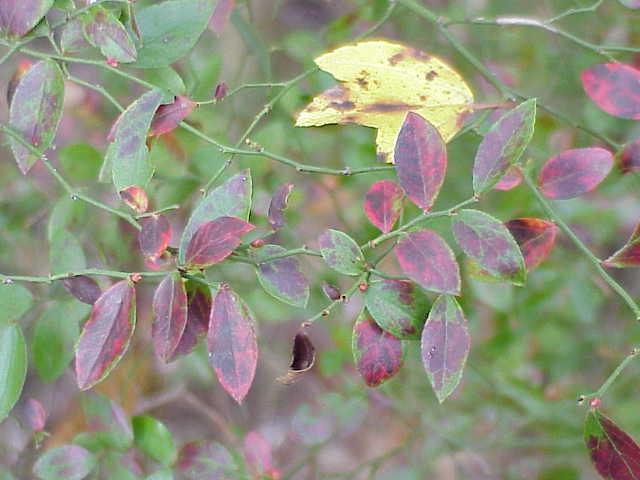
by Beth Bolles | Sep 18, 2025
Many gardeners enjoy plants that attract butterflies and there is no shortage of beautiful flowering plants to supply nectar for all our pollinators. One critical part of making habitat for butterflies that we may need to improve upon is supplying plenty of host plants for butterfly development. While we enjoy the flight of a butterfly through our garden, we really want to offer features that keeps them around.
Your landscape likely includes a few host plants and maybe you even have a citrus tree or plant parsley every season. What many people don’t realize is how many native trees serve as host plants for butterflies. Some of these plants like specific environments while others can grow in a wide variety of habitats.
The Black cherry (Prunus serotina) and Cherry laurel (Prunus caroliniana) serve as host to a large number of butterflies. A more well know species that uses the native cherries for development is the Tiger swallowtail. Although we might consider these trees weedy, they can serve as hosts to hundreds of species of butterflies and moths along with providing berries for wildlife. The black cherry will be deciduous while the cherry laurel is evergreen. Both have flowers in late winter or early spring. Just be aware that the cherry laurel fruit can have some toxicity in different developmental stages.
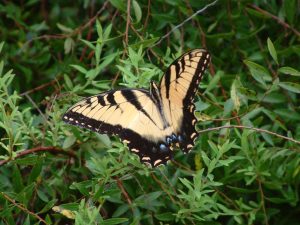
Yellow form of the Tiger Swallowtail. Some females can also have mostly black coloration to prevent predation. Photo: Beth Bolles, UF IFAS Extension Escambia County.
The Winged elm (Ulmus alata) is gaining in popularity as a landscape tree. The Question mark butterfly will lay eggs on plants under the elm and then caterpillars crawl up to feed on elm leaves. The reason we don’t see this butterfly on flowers as much is that it also feeds on manures, carrion, and rotting fruit. Resting butterflies have wing patterns that make them look like leaves.
If you have a site with moist soil or can supply routine moisture, consider the Sweet bay magnolia (Magnolia virginiana). It will attract the Tiger, Palamedes, and Spicebush swallowtails for development. Flowers on the tree are not as large as those on Southern magnolia but you still have similar appearance and even a pleasant fragrance.
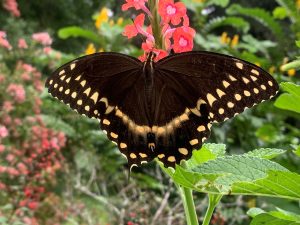
Palamedes swallowtail butterfly feeding on a porterweed. Photo by Beth Bolles, UF IFAS Extension Escambia County.
A couple of understory trees are the Pawpaw (Asimina triloba) and Sparkleberry (Vaccinium arboreum). Look for the Zebra swallowtail to find the Pawpaw while the sparkleberry will serve as host to hairstreak butterflies.
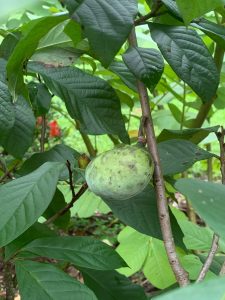
Pawpaw also offers delicious fruit. Photo by Beth Bolles, UF IFAS Extension Escambia County.
Even though landscapes may have limited spaces for every host plant, we can preserve some spaces around borders for native trees. These plants will make a positive impact for butterflies and pollinators.
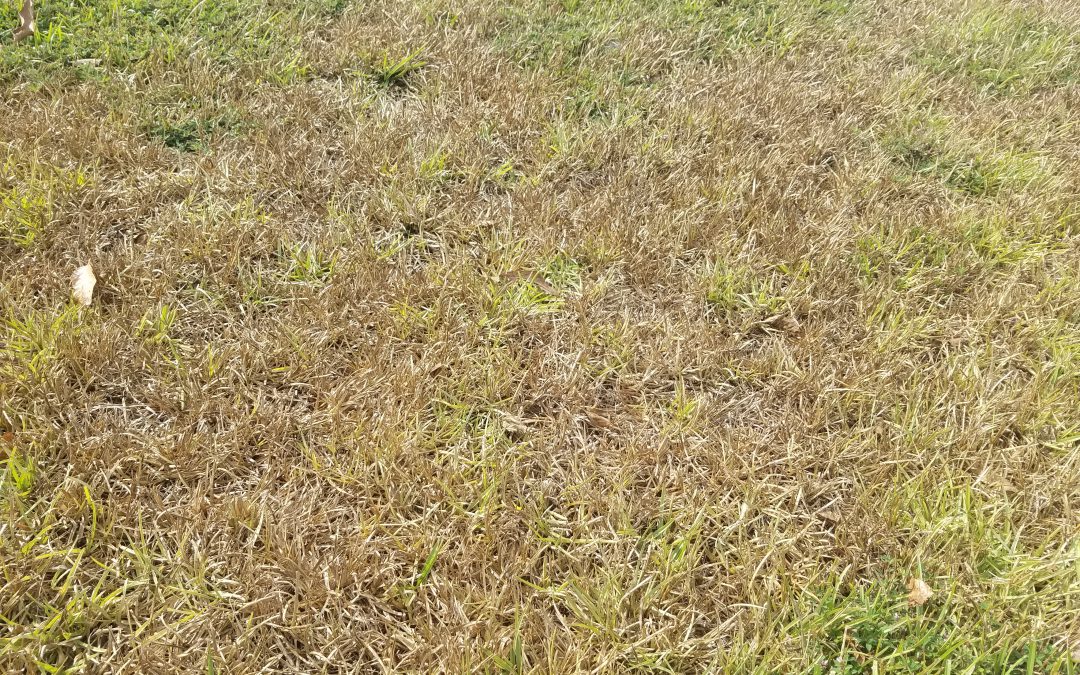
by Daniel J. Leonard | Sep 11, 2025
Many turfgrass yards, including mine, are feeling the effects of an extended droughty period this month. While one of the benefits of the primary turf species grown in the area (Centipedegrass, Zoysiagrass, Bermudagrass, and Bahiagrass), is their drought tolerant nature, they aren’t impervious to drought. Even with these tough grass species the difference between a yard coming out of a drought in decent shape versus dead is as simple as remembering the answers to the following four maintenance questions.
How much should I water to keep my grass alive?
Lawngrass needs about ¾-1” of water per week to remain looking its best and growing vigorously. Obviously, unless you have an irrigation system, keeping a large yard of turfgrass in that ideal water range is going to be hard or impossible. So, what to do? I encourage homeowners to focus their efforts on keeping grass around highly visible and often used areas of the yard well-watered, letting outlying areas fend for themselves until rain resumes. To ensure you’re putting out the optimal ¾-1” of irrigation per watering event, spread a few straight sided cans (tuna or cat food cans work great) under the sprinkler’s range, allow it to run until you reach the 1” mark, and note how long it took to apply that amount of water. This will help you dial in your watering and ensure water isn’t wasted.
Should I mow during a drought?
We all know that an unmown yard looks unkempt. However, given that mowing is a major stress on turfgrass, mowing during a drought can weaken your yard’s ability to recover when the drought ends. If you must mow to keep things looking neat, try to mow only areas that you keep watered and raise your mower’s deck to reduce the amount of leaf tissue you cut from the grass. Mowing in this manner will reduce stress on your turf and keep the yard from appearing weedy and unkempt. My unirrigated Centipedegrass yard has been flowering and setting seed over the last few weeks. My last mowing event (during the current dry period) was designed to only remove seedheads and minimize removal of leaf tissue.
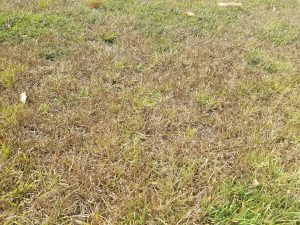
Unirrigated Centipedegrass turf showing drought stress – photo courtesy of Daniel Leonard.
Should I fertilize?
This one is easy! Don’t fertilize grass during a drought! For one, fertilizer promotes growth, and grass isn’t trying to grow during a drought, simply survive. Fertilizing in these times is another unnecessary stress. Additionally, fertilizer requires water to transport nutrients down to the plant roots. If there is no water to do so, it will simply sit there and wait on rain. Also, some or all the nitrogen in the fertilizer applied will volatize and return to the atmosphere, wasting your time, money, and effort and stressing your turfgrass in the process. Hold the fertilizer until rain begins again.
What do I do about weeds?
Turfgrass isn’t the only thing stressed during droughts; weeds are as well. During stressful events like droughts, all plants (weeds included) stop growing and enter survival mode. This has major implications for weed control, as herbicides are not particularly effective on weeds with drought defenses up. In addition to being ineffective, herbicides can injure stressed turfgrass, preventing a healthy recovery post-drought. So, keep the herbicide off the yard until the weeds, and your turf, are happy and growing again.
Maintaining an unirrigated lawn during drought is more about what you don’t do – less mowing and no fertilizer or herbicide applications – than what you do. Mowing too low, applying fertilizer, and trying to control weeds with herbicide are all potential stressors of turf and can inhibit its recovery when the rain returns. The best you can do to keep your lawn healthy in dry times is to apply ¾-1” of water per week and pray for rain! For more information about lawn management or any other horticultural topic, contact your local UF/IFAS County Extension office.
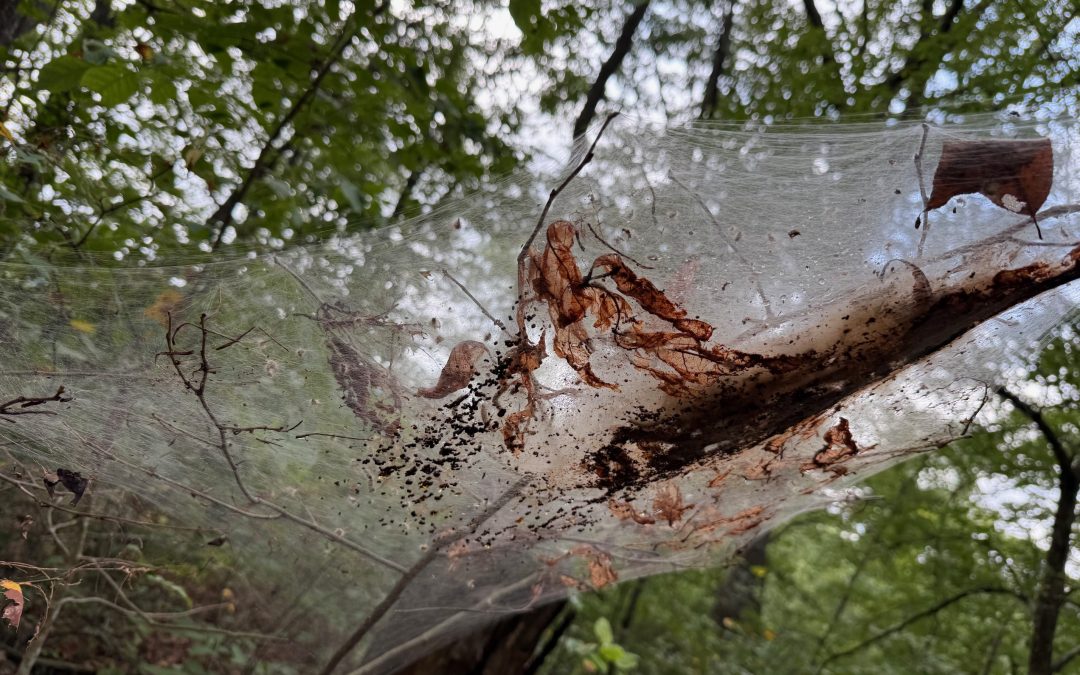
by Carrie Stevenson | Sep 11, 2025
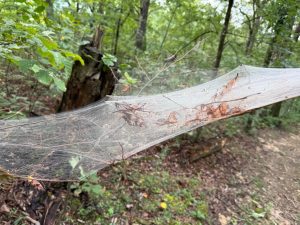
Fall webworms in a Tennessee forest. Photo credit: UF IFAS Extension
Have you ever noticed the big knots of webbing in some trees this time of year? They’re usually sort of a brown-pink hue, much too big for a spider but not really tightly wound enough to be a nest or cocoon.
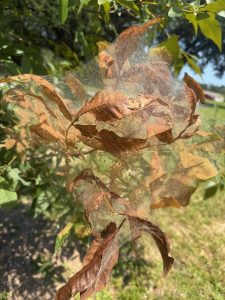
A close-up of the fall webworm tent reveals dozens of tiny caterpillars and skeletonized leaves. Photo credit: Carrie Stevenson, UF IFAS Extension
What you’re seeing actually is a cocoon of sorts—a big shared one created by hundreds of larval fall webworms (Hyphantria cunea). This common name is a bit of a misnomer. The webbing—often referred to as a tent—is built in late summer, not fall, and these are caterpillars, not worms. But I suppose it gets the idea across!
On a recent hike, I saw webbing up close, so I was able to really investigate the caterpillars inside. They are quite small, and will undergo up to five molting stages, or instars, before adulthood. Upon transformation, they will become white or speckled moths. Fall webworms are native to the entirety of the United States—in the northern end of their range the moths will be solid white, whereas further south they will have darker spots on their wings. Due to accidental introduction, fall webworms are invasive throughout Europe and portions of Asia.

Adult fall webworm, with spots on white, which is typical for members of this species from the southern part of its range. Photo credit: Lyle Buss, UF
Host plants include a wide range of more than 80 deciduous hardwood species, allowing a broader spectrum of places for the caterpillars to undergo their various larval phases. During their months in the “tent”, the larvae feed on and skeletonize the leaves encapsulated within their webbing. This causes damage to the leaves, but results in no permanent issues to the trees—being late summer and fall during their tenure, the trees eventually lose their leaves anyway.
While the tents are a bit unsightly, controlling the caterpillars or removing the webs is unnecessary. Once they’ve reached their final caterpillar stage, they’ll hide out in tree bark and leaf litter on the ground until metamorphosizing into moths the following spring. Adult moths mate and lay eggs in the late spring and summer, starting the cycle all over again.

by Ben Hoffner | Sep 11, 2025

Photo credit to Daniel Leonard, Calhoun County Extension Agent
When maintaining proper care of your trees and shrubs in your lawn or landscape it is important to not damage stems and trunks. It is best practices to keep the area around the tree clean, but it needs to be done properly. Mowing and weed eating is not recommended due to the possibly of severe damage to the trunk and stems. Repeated damage from mowers and weed eaters cause damage called girdling. There are a few very effective ways to protect the trunk and stems from damage such as mulching and using tree rings/tubes.
Repeated damage to the base of the tree and stems will affect the cambium layer. The cambium layer is a thin layer of living tissue directly under the bark of the tree, and it supports the growth and well-being of the tree, actively dividing cells located between the xylem (wood) and phloem(bark). Constant damage of this layer will cut off the flow of carbohydrates to the roots, which will cause the tree to die. This layer is the green material you see after the bark of the tree has been damaged. It is imperative to keep the cambium layer damage free to insure the best tree health.

Photo credit to Daniel Leonard, Calhoun County Extension Agent
Taking preventive measures will ensure the prolonged life of your tree. Using mulch around the perimeter of the tree for protection from injury is the most effective method of protection. There are different mulch types like straw, bark, leaves, needles, wood or grass. These are examples of organic mulches. Tree rings and tubes can be helpful to protect young trees. If mulch is not the best option for the plant, other materials such as cut sections of plastic pipe or rubber tires could be an option for protection.
Mulch is not only a great way to protect your trees from injury. It also helps with retaining moisture, erosion control, weed suppression, organic accumulation and aesthetic appeal. Following simple guidelines when using mulch will make sure that you are maximizing the material used. Maintain a 2-to 3-inch layer around your established trees. Avoid “volcano mulching”. “Volcano mulching” is when mulch is piled against the base of the tree, it holds moisture. High amounts of moisture can cause the trunk to rot.
To prolong the life of your trees and shrubs you must protect them from injury that can cause girdling. Avoid constant contact with lawn mowers and weed eaters that will destroy the cambium layer. Using mulch is a very effective way for protection as well as retaining moisture, erosion control, weed suppression, organic accumulation, and aesthetic appeal.
For more information contact your local UF/IFAS Extension Office.

by Abbey Smith | Sep 4, 2025
As we transition from the dog days of summer into (hopefully) the cool weather of fall, it is a great time to consider the nutrient levels of your garden soil. One of the best things you can give your garden is the foundation of healthy soil, but to do that you may have to add some things over time. A natural way to boost your garden’s nutrient levels is through composting. But what exactly is compost and where can you get it?

Handful of finished compost soil. Photo Credit: UF/IFAS Tyler Jones
Compost is often referred to as “black gold” by gardeners because of its nutrient dense consistency. And even better, you can make your own compost from home. Compost is the makeup of an even ratio of carbon and nitrogen by-products that naturally decompose over time to create a brown-soil like substance. Carbon products are often referred to as “browns” and nitrogen products “greens.” Examples of browns are straw, cardboard, and old leaves. Green materials are often food scraps, lawn clippings, and animal manures. Compost can be added and tilled into your garden or depending on the type of compost, it can also be used as a potting soil alternative.
It is easy to create a compost bin at home. It does not have to be fancy or expensive to create. Some people opt for a pre-made compost tumbler bin to make turning their pile easier, while others use old wood pallets for their siding. You can even create a vermicompost bin inside a storage tote and use worms to do the composting for you. There are many possibilities. But it is important to note that bins do create a slight odor, because they are breaking down waste products. Location of your bin should be kept in mind if you don’t want close neighbors or even family members making complaints about the smell. However, if there is a strong odor overtaking, it could indicate an issue with the bin and will need to be addressed. Keeping a 1:25 ratio of greens to browns will keep odors at a minimum.

A compost bin being stirred. Photo Credit: UF/IFAS Cat Wofford
If you are interested in hearing more about compost and getting a hands-on demonstration on how to build a compost bin at home, the Jackson County Master Gardener Volunteers are hosting an informational workshop called Backyard Composting 101 on September 20 at 9:00 am at the Jackson County Extension Office. Admission is $7 per person. Space is limited for this class, so be sure to call 850-482-9620 to pre-register today.
For more information, please visit:
https://gardeningsolutions.ifas.ufl.edu/care/fertilizer/compost/
https://sfyl.ifas.ufl.edu/sarasota/natural-resources/waste-reduction/composting/what-is-composting/methods/
















